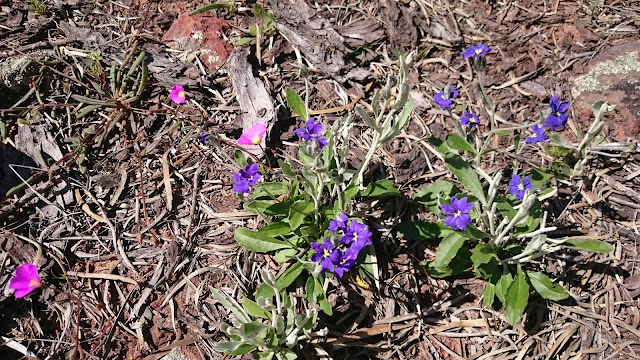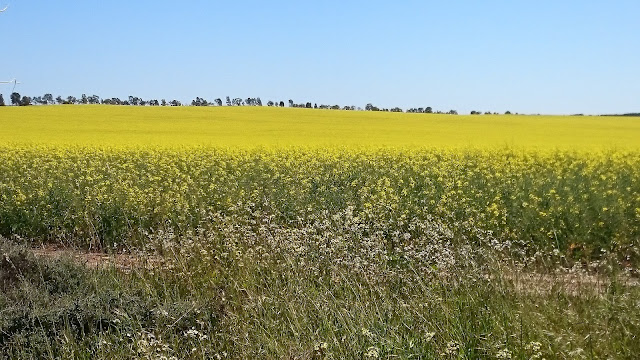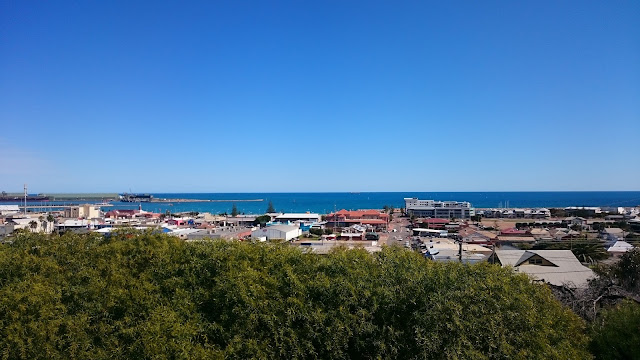We arrived in Geraldton on the
22nd and stayed at the Bellaire Caravan Park.
Geraldton is a medium size
town and is well known for its crayfish industry. It was established in 1850 and has a relatively
recent history. The population is
bordering on 40000 and is approximately 400 Km north of Perth. It is also renown to be very windy most of the
year, as we found out the hard way when our caravan awning was ripped during a
bout of high winds. There are a few
pretty beaches and a lovely look out with a memorial to the sailors who
perished on the HMAS Sidney 2.
We took the opportunity while we
were in Geraldton to visit the town of Mullewa to look at the world famous wild
flowers photos below, in our travels we came across this old chapel which is
very quaint.
We also came across these figures cut out of
steel plates which depicts the region at the time.
Along the way, we decided to drive through the
Greenough region, which is supposed to be famous for wild flowers, however I
found it quite disappointing. Here are
some pics of the area
And
once again, Shirley could not resist taking photos of the wild flowers
We reached the town of Mullewa which is wold
renowned for its wreath flowers. The
flowers grow on the side of the road in a certain spot and nowhere else, quite bizarre. I have yet to find out the reason for this.
The experience was something
that I had not expected and was definitely worth the 100km that we had to
travel to see this. Once again, we came
across fields of wild flowers and Shirley could not help herself taking more
photos
We were fortunate to see this eagle land in a
field not far from us.
The following day we decided to visit a look
out over the town of Geraldton and the Memorial of the HMAS Sydney which was
sunk by the German boat HSK Kormoran near Quabba. The memorial is dedicated to the 645 men who
perished on that day in 1941.
The monument above shows the bow of the HMAS
Sydney 2 and the monument of the dome above this photo is of 645 seagulls in
flight, one for each sailor that perished.
The memorial below shows a seagull flying over a fountain which
represents the sinking of the ship and its location on the West Coast.
Below is a statue of a mother or girlfriend
waiting for the return of her son or lover who would have gone out to sea.
The picture below is of a propeller facing
upward which represents a ship sinking.
Below is a memorial wall with the names of the
645 sailors who perished on that day in 1941
We found the memorial very well presented and
the tour guide who volunteers his time for the cause very informative.
The following day we explored the town of
Geraldton and a goal in the area, life would have been tough in that era.
I was not brave enough to leave her there,
besides she would have done the same to me.
Here is a short history of the gaol.
Inside the gaol
A history of brave escapes
This is the size of the cell, note the slop
bucket on the left.
Some of the punishment dished out at the time.
And the cell for those who would self-harm
themselves.
And here is a list of persons executed in Perth
and Fremantle for crimes committed in the Victoria district.
The photo is of the solitary confinement cell.
A typical bed and the ratio that each prisoner
received every day.
We left the gaol and went for a drive along the
beach front when we came across this guy holding a placard warning us of a
speed camera ahead of us.
And true to his word, we found the police
vehicle with a camera 100 meters or so ahead of us.
Although we copped some heavy wind, we enjoyed
our stay in Geraldton but we were ready to leave after 5 days.
Jurien Bay
We left Geraldton for the small town of Jurien
Bay and Cervantes which are two coastal holiday villages north of Perth. Both towns are equally pretty, however with
the weather turning on us and the wind coming up, it was not pleasant out on
the beach, we took the opportunity to catch up with some grocery shopping and
washing etc. I took the time to do some
fishing off the pier and then we went to visit the Pinnacles, on our way to
Cervantes and the Pinnacles we stopped at this museum.
After our visit to the museum, we drove down to
Cervantes and as the weather was not the greatest with high wind gusts we did
not spend too much time at Cervantes. We
took the opportunity to try out the “world best hamburger” as advertised at a
local pub and as predicted we were disappointed once again. I must say that
every time we eat out lately, we are disappointed. However, the view from a viewing platform of
Cervantes was not disappointing.
As we were driving back to Jurien Bay we came across this sign of a
leaning tree and as this coast gets hammered with the wind it was not
surprising to see a tree grow at such an awkward angle.
And here is the actual tree
I spent some of the time fishing off this jetty
with not much luck, I only managed to get a few small mullets.
The view from the jetty looking back, note how
the sea weeds had washed up on the beach with all the wind that we had.
On the last day of our stay we went to see the
pinnacles, which are small outcrops of lime stone rocks jutting out in what
looks like a desert surrounded by lush greenery. We were fortunate that we could leave the
dogs in a kennel at the Parks conservation offices for the duration of or visit.
Some of these Pinnacles are over 2 meters tall
and absolutely fascinating. These
pinnacles would have been a small hill which would have eroded over time with
the wind and rain.
We left the Pinnacles, fetched the dogs and
made our way back to the caravan park to prepare for our travel the next day to
Perth.
Next stop Perth at last.
Map for this trip.























































































No comments:
Post a Comment
Note: only a member of this blog may post a comment.